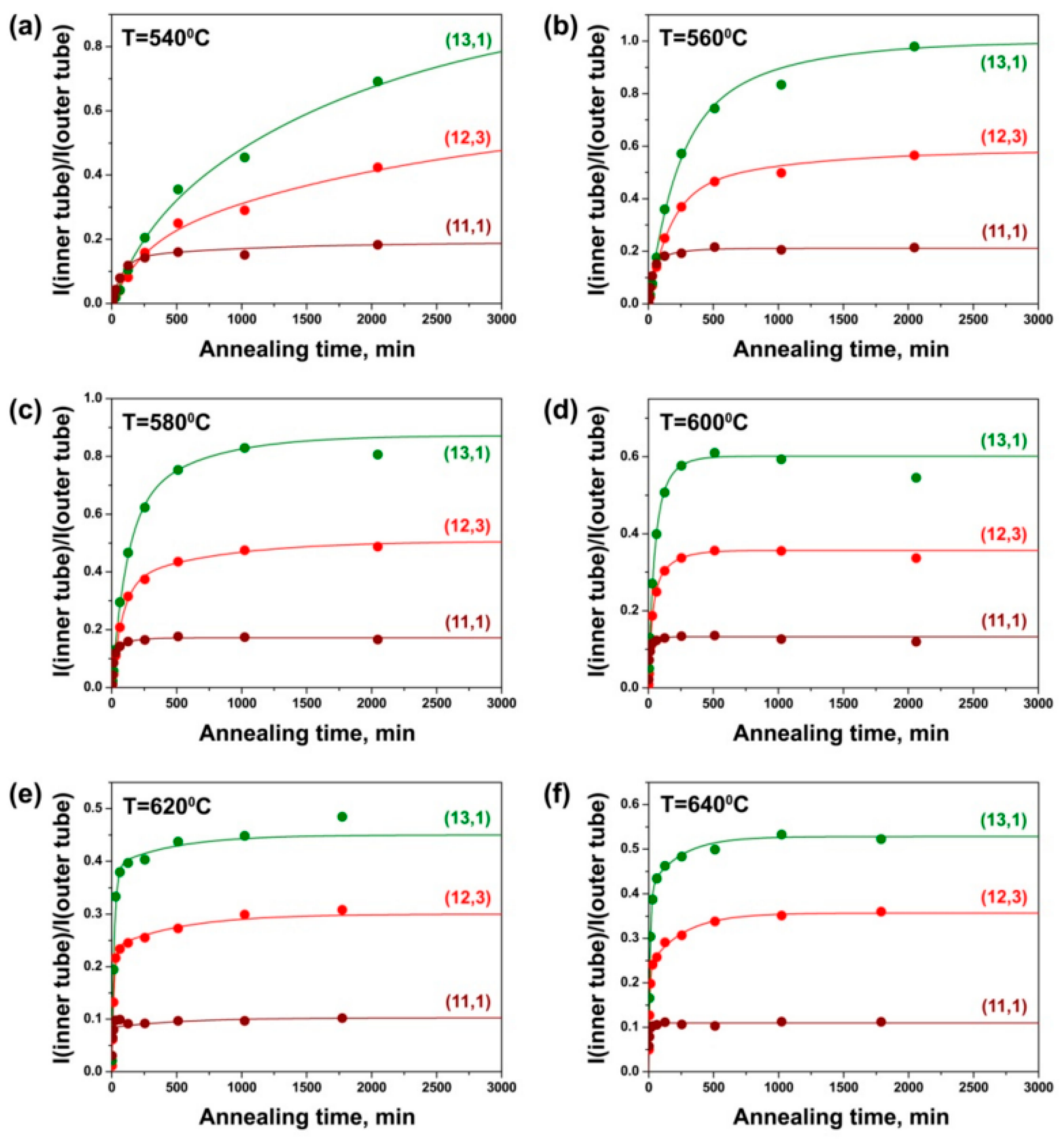Growth of Inner Carbon Nanotubes inside Cobaltocene-Filled Single-Walled Carbon Nanotubes †
Abstract
:1. Introduction
2. Experiments
3. Results
4. Conclusions
Funding
Institutional Review Board Statement
Informed Consent Statement
Data Availability Statement
Conflicts of Interest
References
- Kharlamova, M.V.; Kramberger, C. Applications of Filled Single-Walled Carbon Nanotubes: Progress, Challenges, and Perspectives. Nanomaterials 2021, 11, 2863. [Google Scholar] [CrossRef] [PubMed]
- Kharlamova, M.V.; Kramberger, C. Metal Cluster Size-Dependent Activation Energies of Growth of Single-Chirality Single-Walled Carbon Nanotubes inside Metallocene-Filled Single-Walled Carbon Nanotubes. Nanomaterials 2021, 11, 2649. [Google Scholar] [CrossRef] [PubMed]
- Kharlamova, M.V.; Kramberger, C. Spectroscopy of filled single-walled carbon nanotubes. Nanomaterials 2022, 12, 42. [Google Scholar] [CrossRef] [PubMed]
- Kharlamova, M.V. Advances in tailoring the electronic properties of single-walled carbon nanotubes. Prog. Mater. Sci. 2016, 77, 125–211. [Google Scholar] [CrossRef]
- Kharlamova, M.V. Electronic properties of pristine and modified single-walled carbon nanotubes. Phys. Uspekhi 2013, 56, 1047–1073. [Google Scholar] [CrossRef]
- Kharlamova, M.V.; Kramberger, C. Metallocene-filled single-walled carbon nanotube hybrids. Nanomaterials 2023, 13, 77. [Google Scholar] [CrossRef] [PubMed]

Disclaimer/Publisher’s Note: The statements, opinions and data contained in all publications are solely those of the individual author(s) and contributor(s) and not of MDPI and/or the editor(s). MDPI and/or the editor(s) disclaim responsibility for any injury to people or property resulting from any ideas, methods, instructions or products referred to in the content. |
© 2023 by the author. Licensee MDPI, Basel, Switzerland. This article is an open access article distributed under the terms and conditions of the Creative Commons Attribution (CC BY) license (https://creativecommons.org/licenses/by/4.0/).
Share and Cite
Kharlamova, M.V. Growth of Inner Carbon Nanotubes inside Cobaltocene-Filled Single-Walled Carbon Nanotubes. Environ. Sci. Proc. 2023, 27, 15. https://doi.org/10.3390/ecas2023-16351
Kharlamova MV. Growth of Inner Carbon Nanotubes inside Cobaltocene-Filled Single-Walled Carbon Nanotubes. Environmental Sciences Proceedings. 2023; 27(1):15. https://doi.org/10.3390/ecas2023-16351
Chicago/Turabian StyleKharlamova, Marianna V. 2023. "Growth of Inner Carbon Nanotubes inside Cobaltocene-Filled Single-Walled Carbon Nanotubes" Environmental Sciences Proceedings 27, no. 1: 15. https://doi.org/10.3390/ecas2023-16351
APA StyleKharlamova, M. V. (2023). Growth of Inner Carbon Nanotubes inside Cobaltocene-Filled Single-Walled Carbon Nanotubes. Environmental Sciences Proceedings, 27(1), 15. https://doi.org/10.3390/ecas2023-16351




